Italian Stallions
Maybe you saw the movie "The Red Violin" where an Italian instrument maker uses the blood of his beloved wife to cure the wood of a special violin thus turning it in something almost supernatural in sound production. Passed down through the generations, the violin "sings" like no other. Now we're not saying that buckets of Type A are poured into the likes of the following Italian stallions, but there is definitely some alchemical reaction taking place. They are literally too sexy for their tires. Always have been. Always will be. If they could cook, I would marry any one of them. Come to think of it, cook they do!
The following bikes showed up at one of the annual Italian and French Car Shows held in the Los Angeles area's Woodley Park. Well, make that ex-annual. The bikes were invited to join the four-wheelers for two years, then on the second and ultimately last year, the French car guys freaked when someone lit up an open piped three-cylinder MV one too many times. It probably shook off a couple toupees so the Italian bikes weren't invited back. The show's loss. So for those MO readers that didn't make that last show, here are the winners of the competition. Come to think of it, I think every bike there won an award, and damn rightly so.
They are literally too sexy for their tires. Always have been. Always will be.
1972 Moto Guzzi V-7 Sport - owner: Bill Ross
A couple years after WW1 ended Carlo Guzzi flipped the motorcycle world on its ear, literally... thanks to the sound issuing from his remarkable engine - a horizontal single cylinder 500cc overhead camshaft, 4-valve head with dual spark-plugs - a configuration that was way, way ahead of the game. Unfortunately, it was like one of those concept cars we see, droolable but not doable, at least not according to the bean counters, even back in 1920 when they were counting pasta shells or something. In any case, Carlo produced a simpler, cheaper, but still very popular motorcycle...the first of the now beloved Guzzi line. How beloved? In 1927, the company produced an amazing 52,673 motorcycles (and another 25,000 vehicles to boot). The company knew a good design when they saw it... practical, tough, trustworthy, simple... and proceeded to keep the horizontal singles thumping off the assembly line for more than half a century, with the last one built in 1976, a true testimony to Moto Guzzi skilled engineers.
Guzzi then took a major fork in its evolutionary road when, in 1967, they came out with a transverse V-win often compared in impact to Honda's first 750-four. The Mandello del Lario factory relied on the brilliance of Lino Tonti who started conjuring up the V7 back in the 1950s. He designed a lighter lower frame by moving the generator from the top of the engine to the front end of the crankshaft. The first model was called the 750 V7 Sport, of which the first 200 were handmade. The V7 Sports were raced, including at Le Mans. This was the ancestor to the later incarnation V7 Sport as seen here. The later 750S, 750S3 and 850 Le Mans, were also based on this frame design. In standard form the 700 cc, 507 lb. cruiser made 40 hp and was good for 102 mph. In 1970, in an attempt to establish a more sporty image, they brought out the V7 Sport. Last built in 1975, they are highly sought after as both a ride and a collectible.
1993 Moto Guzzi 1000S - owner: Rich Kissel
Clean, crisp uncluttered lines, an engine with plenty of mid-range torque, and ease of maintenance... a Guzzi that zizzled.
Benelli 750 Sei - First Six Pack
The six Benelli brothers built a wide spectrum of bikes, beginning in 1927, including both street and race machines that included their sohc and dohc racers, of which their 1930s 250cc was still racing into the 1960s. Race success translated to street sales (they even built beautiful trikes for commercial use). In 1940 they debuted a supercharged, water-cooled, 250cc four-cylinder that pumped out almost 53 hp at 10,000 rpm, and screamed it's way past 143 mph. Yes, a 250... four tiny pistons making massive power. But as we all know, brothers can squabble (usually over love or money, right?), and in 1950 brother Giuseppe launched his own company, Motobi, and designed their famous egg-shaped engine/cylinder configuration. Benelli made their own "egg" engine in 1956 with a bike they called the Leoncino. So they're In 1940 they debuted a supercharged, water-cooled, 250cc four-cylinder that pumped out almost 53 hp at 10,000 rpm, and screamed it's way past 143 mph. Yes, a 250... four tiny pistons making massive powernot faint of heart when it comes to pushing the envelope with machines that take a decidedly different fork in the road.
For example: the first "Six Pack" production motorcycle, which started back in '69 when things brightened for Italian bike builders thanks to Argentinean industrialist Alejandro de Tomaso (remember the Mangusta/Pantera) who bought both Moto Guzzi and Benelli. Deep pockets always help.
However, by the early '70s Japanese bikes were clobbering at both the racetracks and the showrooms. Italy felt the impact as well and did not climb out of the trough until the 1980s. Benelli was the exception and broke out in 1973 with their own vision of a "superismo-bike," the 750 "Sei", the first production six-cylinder motorcycle. Yeah, sorry, CBXers. In 1980 the displacement was increased to 900, with the last Sei appearing at the Bologna bike show in 1986. Not a particularly good year for Benelli, who although marketing a dozen different models, only sold 5000 bikes. Today the Sei is a prized collectible thanks to its six cylinder engine and certainly the fearsome sound emitted by its six pipes. Top speed for the 485 lb. stock bike was around 135mph.
1959 Ducati 200 Super Sport - Owner - Alan Chalk
Taking their success to the street, Ducati brought out the now very rare 200 Super Sport in 1957 and continued in production into 1964. It sported a bigger cam and a single muffler as compared to its predecessor's dual piped 175. It also wore the very unusual so-called "jelly-mold" gas tank that had appeared on 175's though not chromed as on the 200. As far as its "squashed and bent" look, apparently it was designed with rider ergonomics in mind including indentations for knees and placement for folded arms, all to facilitate a crouched riding position at speed. There's also an attachment for a pad on top of the tank on which the rider would rest his chest. In any case, it is a work of sculpted art for Ducati fans and gets nominated for one of motorcycling's most distinctive gas tanks.
1972 Ducati 750 Imola - owner: John Stein
First off, Imola stands for "I Must Own Los Angeles," a bumper sticker seen on a lot of SUVs with drivers blathering on cell phones while executing one-handed u-turns in the middle of rush hour traffic. Actually, Imola is a racetrack in where else but Italy, and the scene of the famous Imola 200 first run in 1972. In less than three years it had garnered status as the premier Formula 750 event in Europe. The race organizers borrowed from the Daytona format of a 200 mile course with a big purse at the end for the winners. At the first staging of the event you could ride anything you could climb on as long as it displaced from 500-750cc, an effort by the organizers to eliminate the superfast Yamaha 350 production racers but also to inspire Italian motorcycle builders to get into the 750 fray with racers based on their production bikes.
Seen here is one of the original factory racers, literally one of one handful of such machines.
Paul Smart, on a 750 Ducati, would have the honors of winning the first Imola while Ducati also snatche
1977 Ducati 900 Super Sport - owner: Charley Sullivan
Diana (aka Daytona) sports version. The bike's sohc set-up was less expensive than the racebred desmo drive. Next came the Mach 1's and 5-speed Mark 3 plus the 350cc Sebring. Then in 1968 they brought out their first desmo singles in various flavors of 250, 350 and 450. Eventually they stuck two of the cylinders together and made history with their legendary 750SS debuting in 1971. While displacements tend to grow to keep up with the Jones's, in 1976 the 750 was bored out to a 900 (actually 864) and for ten years the 900SS desmo was "the" sportbike, and the Holy Grail on wheels for purists. So what if it wasn't comfortable, it looked marvelous and still does. While Japanese multi's had more h- power, the SS with 73 hp/127 mph was 100 lbs. lighter and its torquey 90-degree V-twin straightened out the twisties faster than you can say Honda, Suzuki, Kawasaki and Yamaha.
1989 Ducati 900SS - owner: Michael Derderian
Some people can't leave well enough alone... they need to provide it with company. Such is the case with the later iteration of the 900 Super Sport. The restyled, though mechanically very similar, SS first appeared in 1983 and promptly found a loyal following.
Ducati 1982 600 TT2 - owner: Ted Henry
1988 Ducati 750 FI - owner: Alan Chalk
No frilly stuff here, just rawness and sound with real fury.
Claiming direct descent from the mother of all Ducati sportbikes, the 750SS, the later incarnation 750 F1 is still thought of as the last real McCoy, or should we say, real McDuck by Ducatistis. No frilly stuff here, just rawness and sound with real fury. After the advent of the F1, Ducati Meccanica was assimilated in May of 1985 by the Castiglioni conglomerate Cagiva which would also acquire the likes of MV Agusta, Moto Morini, Aermacchi and Husqvarna and so in many eyes ended the "original" Ducatis. However that's all been eclipsed over the last several years by Ducati's phenomenal rise to stardom once again.
While embraced by the media from selling underwear to stock shares, the Ducati still retains its chicness, its panache, its cache, and all those other French words the Italians probably don't like. In this case, the 750 was based on Taglioni's enduring Pantah desmo engine, first appearing as a works racer in 1983. Two years later and you could walk into your local exotic bike dealer and buy a production race model for street or track use... or both. In the mid to late 80s you could find whole starting lines filled with factory and privateer mounted F1's. Capable of 140 mph and tipping the scales at around 390 lbs, no one has been able to count up the number of wins garnered around the globe by these racebred Italian stallions.
1958 MV Agusta 175 - owner: Ted Henry
In its first big race, the Belgian GP, the new racer came in fourth...behind three Gileras.
MV Agusta 750S
When Count Agusta unleashed the 750S at the 1969 Milan Bike Show it signaled a major public image makeover for MV Agusta which had been known for its relatively sedate 600cc touring mounts (and later its helicopters), quality machines that they were. But here was bottled adrenaline plus extra dollops of ginseng guaranteed to grow hair on the baldest pulse rate.
The 750S gained superstar collector status and still holds its own as a "must have" for the Italian bike fan and about any collector for that matter. The 750S gained superstar collector status and still holds its own as a "must have" for the Italian bike fan and about any collector for that matter. Back in '69 it was just too expensive to make due to the complexity of the engine internals which were based on MV's fearsome '50s GP bikes. Even when they sold, the Count basically lost money on the deal. They certainly couldn't compete pricewise with what the Japanese were offering. And the performance was not that awe inspiring...66 bhp at 7900 rpm. However, the oversquare four-banger ran surprisingly smooth and flexible. Some think oddly enough, MV chose to utilize a shaftdrive instead of the traditional chain drive. This succeeded in limiting its racing ability while another sales impacting factor was that they chose basically a race engine for the street, one initially designed with no provision for a generator or starter. As a result the engineers had to mount an external dual-pulley starter motor/dynamo below and aft of the engine strung together by a pair of pulley belts. The engine made so much internal noise that one magazine described it as "the world's most sophisticated gravel-cruncher." Ah, but there was the beautiful sandcast engine cases. In fact there was beauty everywhere. Veglia instruments, Tommaselli clip-ons, Borrani rims, Fontana four-leading shoe front brake, Ceriana forks and those four chromed exhaust pipes making raw visceral sound waves that stirred the marrow in your bones.
The bike itself was even greater than the sum of its parts to boot. Stand in the presence of an MV 750S and tell me your breath isn't sucked out of you.
1976 Laverda 1000 Jarama Triple - owner: Sheldon Payne
I
The bike rose off the ground like a ballet dancer, completely level, complete stable, not a wobble on the front end, then landed as if it had never left the ground...
Then there were the three 750 twin cylinder GT's I bought as a "package," selling two and restoring the most complete of the lot, although stored some twenty years. The cost of rechroming the pipes and a couple small parts was more than what I had paid for the entire bike. I painted it myself, something like 15 layers of chrome yellow, thick enough to stop a .38 slug. It was the closest I got to a 750SFC, one of the most b-u-ta-full bikes ever. They all went, poverty being one of the perks of a freelance writer.
In any case, the 1000 Jarama seen here was called the 3CL by the factory. The 3C stands for three cylinders, the L stands for alloy wheels and Jarama is a racecourse outside Madrid, Spain. All the bikes were either red or green. So now you can go play trivial motorcycle pursuits. The triples were 140 mph machines first appearing in 1973, the Jarama getting triple disc brakes over the previous drum-braked editions. The 980cc thunder machine was rated at 80 hp at 7200 rpm and could make about 128 mph. Many consider the triple cylinder arrangement the ideal design layout for a motorcycle, albeit an expensive one and thus not often used in a production machine. The ads used to call the Laverda "The Lamborghini of Motorcycles." The Laverda is rare wine indeed, to be sipped judiciously and uncorked when one is ready to experience an all-sensory experience. Is it obvious that I want, nay, need a Laverda, and real bad.
A special thank you to Joe Yee for use of the photos and to Joe, Roy Kidney and Paul Montgomery... all Italian bike aficionados, riders and restorers par excellence... for their assistance in answering my inquiries.
And don't blame them for any mistakes. For those I take full credit. By the way, you vintage Moto Guzzi fans should check out Paul Montgomery's excellent Web site www.guzzino.com. They are some great parts and we're not just talking the Guzzigirl section.
More by Paul Garson



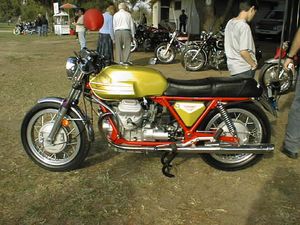


















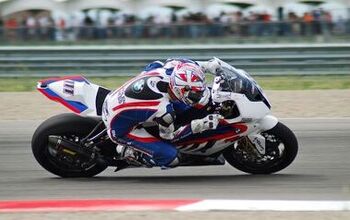
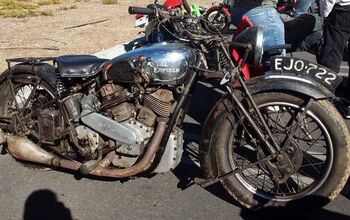
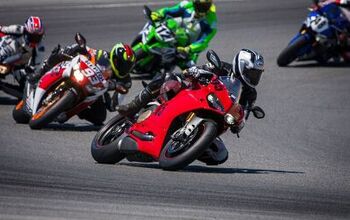
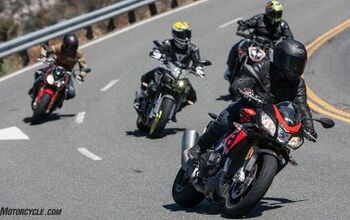














Comments
Join the conversation